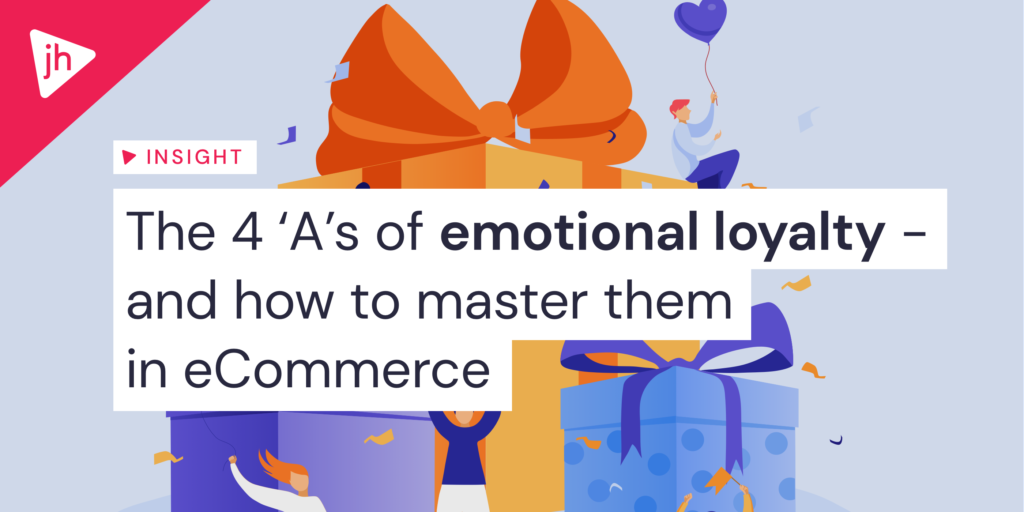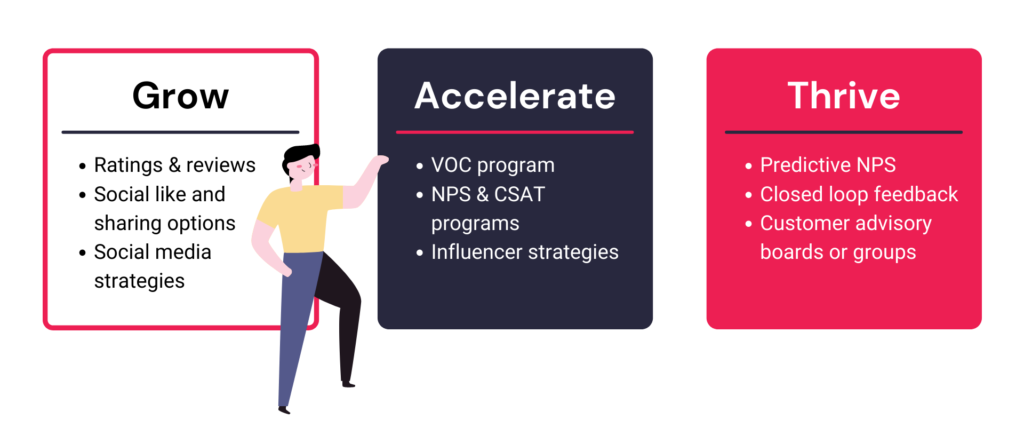The 4 ‘A’s of emotional loyalty – and how to master them in eCommerce
Do you know how to build emotional loyalty for your eCommerce brand? If not, you will by the end of this post.
Loyalty is always a hot topic in eCommerce – we’ve certainly been banging the loyalty drum here on the JH blog over the last month – and we always welcome further discussion on how merchants can improve their loyalty strategies. Here, we’ll be deep-diving into emotional loyalty in eCommerce – so get ready to learn what it is, how to measure it, and the types of tactics you should be incorporating into your strategies to really leverage long-term success.

New century, same loyalty strategy?
While brands working to build customer loyalty certainly isn’t a new thing, loyalty-building tactics and programs arguably haven’t changed much since their inception. The first modern loyalty program is reported to have begun in 1793, when a merchant in New Hampshire began rewarding customers with copper tokens – which could be collected and exchanged against future purchases. Doesn’t really sound so different to the loyalty programs we have today, does it?
A traditional loyalty strategy might focus on:
- Directly rewarding transactions
- Incentivising frequency of purchases
- Incentivising cross- or up-selling
- Focus on a customer’s annual spend
However, while they are undeniably popular with consumers, these strategies often can feel a bit lacking to customers – indeed, studies show that 38% of consumers say the biggest problem with loyalty schemes is that the only way to earn rewards is to make purchases. With so many brand touchpoints and digital opportunities, it’s surprising that loyalty schemes haven’t changed with the times; besides, most merchants generally aren’t tracking purchases as their only conversion goals – they’re also striving to increase newsletter signups, customer engagement, social followings, brand sentiment and more.
It almost seems archaic to still only be rewarding customers for their purchases – let’s face it, both the brand and customer know there are other similar – or better – contributions they can make to the overall consumer-to-brand relationship, including social advocacy, personal recommendations, and signal-boosting brand content. Consumers are savvier than ever, and know that a brands’ success (or downfall) depends on their customers – for better or worse.
What is emotional loyalty?
Growing in popularity with forward-thinking brands, emotional loyalty requires strategists to remember something that sometimes seems to be forgotten in a world of digital tools and automation platforms – customers are human, and they are emotional. The most successful brands in the 21st century are the ones that form an emotional bond with their customers, and inspire loyalty beyond products and services: it’s strange that we can feel an emotional bond with a corporation or product line, but that’s exactly what branding is striving to build.
For brands concentrating on building emotional loyalty, there’s a whole additional spectrum of metrics to be focusing on beyond the traditional loyalty KPIs.
Metrics you might want to consider tracking (and working to improve) include:
- Website dwell time
- Content shares
- Participation in surveys or events
- Newsletter opens and clicks
- Customer lifetime value
- NPS scores
- Social engagement
Tracking these metrics won’t necessarily directly impact your bottom line – but they will all feed into the overall success of your brand. Knowing which content is most share-able helps inform your content strategy, helping more customers discover your store. Growing your newsletter open and click rates by examining what increases those metrics will help grow your customer lifetime value – and growing that means you can devote more time and marketing spend to returning customers, which are easier to convert (and spend more) than new customers.
The “Four A’s” of emotional loyalty
One of the ways we’ve seen the complex ideas behind emotional loyalty broken down is in a recent talk at Adobe Summit from Stephanie Bannos, VP Global Lead of Customer Experience Practice at Rightpoint Consulting. You can watch the full talk here – or read on for a summary, along with our top tips for applying it to your own strategies.
The “Four A’s” are essentially four different emotional stages your customers move through after a positive experience with a brand – namely:
- Affinity
- Attachment
- Assurance
- Advocacy
Knowing what each of these are, and how you can help your customers experience them, means you can work towards every single customer feeling positive emotions when they interact with your brand – building that positive emotional loyalty that will allow them to feel attached to your products or services: less of ‘I buy this thing’, more of ‘This thing improves my quality of life’.
Affinity
The first ‘A’ begins when customers first discover you – and here, it’s all about delivering an experience that makes the customer feel like your brand is talking directly to them. No-one likes to feel like a tiny person being broadcasted at by a faceless brand, and it’s one of the reasons that personalisation, reviews, and simple drill-down journeys do so well.
Attachment
Once a customer has shopped with you once, that’s when the second ‘A’ comes into play. Your customers should feel like they’re in the ‘in crowd’ now – they’ve joined the community, and little things like welcome-back messaging, loyalty programs, and exclusive offers will go a long way to make them feel appreciated.
Assurance
Now we’re getting into some serious trust metrics – and this is where it could make or break your customer experience! Customers want to feel assured that your brand will deliver against its promises – unanswered queries, poor public reviews and products or deliveries that miss the expected quality mark will all damage the hard work you’ve done for the previous two “A’s”. On the flip side, offering multiple customer service touchpoints, sooner-than-expected delivery or above-and-beyond service when things go wrong can work far more in your favour.
Advocacy
Ah, the final “A”. Advocacy is where all eCommerce brands want their customers to be – and while you’ll never get all customers to reach this stage of emotional loyalty, there’s plenty you can do to leverage the ones who do. From offering easy review and ratings systems, creating fun content customers want to display on their own social channels, and inviting customers to contribute to market research and product feedback, nailing your advocacy strategies can inform so many different areas to support the success of your business.

But where should I start?
If all those tactics to build emotional loyalty for your eCommerce store have left you feeling overwhelmed – you’re not alone. Implementing everything at once can feel like an insurmountable task, so don’t feel that success will only be achieved by incorporating all the channels we’ve mentioned above. After all – there’s no guarantee that they’ll all work for your brand. So how do you choose what to focus on?
Focus on what you know your customers respond to
For brands who have trialed some of these tactics before, the customer engagement data is invaluable. If you have something you know works – do more of it! Of course, if you’re not sure, it could be the perfect opportunity to reach out to your most engaged customers and see what they think. You might be surprised by the results!
See what others in your industry are doing
If you don’t have your own data to rely on, there’s no shame in researching other brands in your industry to see where their success is coming from. Do they have loyalty schemes? Do they work with influencers? How many customer service touchpoints do they offer? Brands that have stood the test of time in an industry have usually trialed a bunch of different tactics, and settled on the ones that work best for them, so similar brands can be a great source of tried-and-tested inspiration.
But what if you can’t find an example of something in your industry you think would work for your brand? Well, you might not want to discount it completely…
If all else fails, go with your gut
You’re probably the one who knows your customers and brand best – so if you’re torn between a few tactics, focus on the one you think will work. Think about a brand you’d be happy to recommend to a loved one – can you pinpoint what experiences have made you feel that way? It’s often best to go with the most authentic and genuine tactics, too – consumers highly value authenticity in the brands they support.
Need help building emotional loyalty for your eCommerce business?
No marketer can do everything on their own (even if they wish they could). Our eCommerce clients partner with us to access the best knowledge and support for their brand growth – and with access to the latest technologies, tried-and-tested advice on strategy building, and comprehensive research and discovery all part of our service, they can rest assured they’re always working on their brand, not just in it.
If you want to find out how you can take your eCommerce brand to the next level and overtake your competitors, get in touch with us today on +44(0)115 7940245 or drop us a line at breakthrough@wearejh.com.